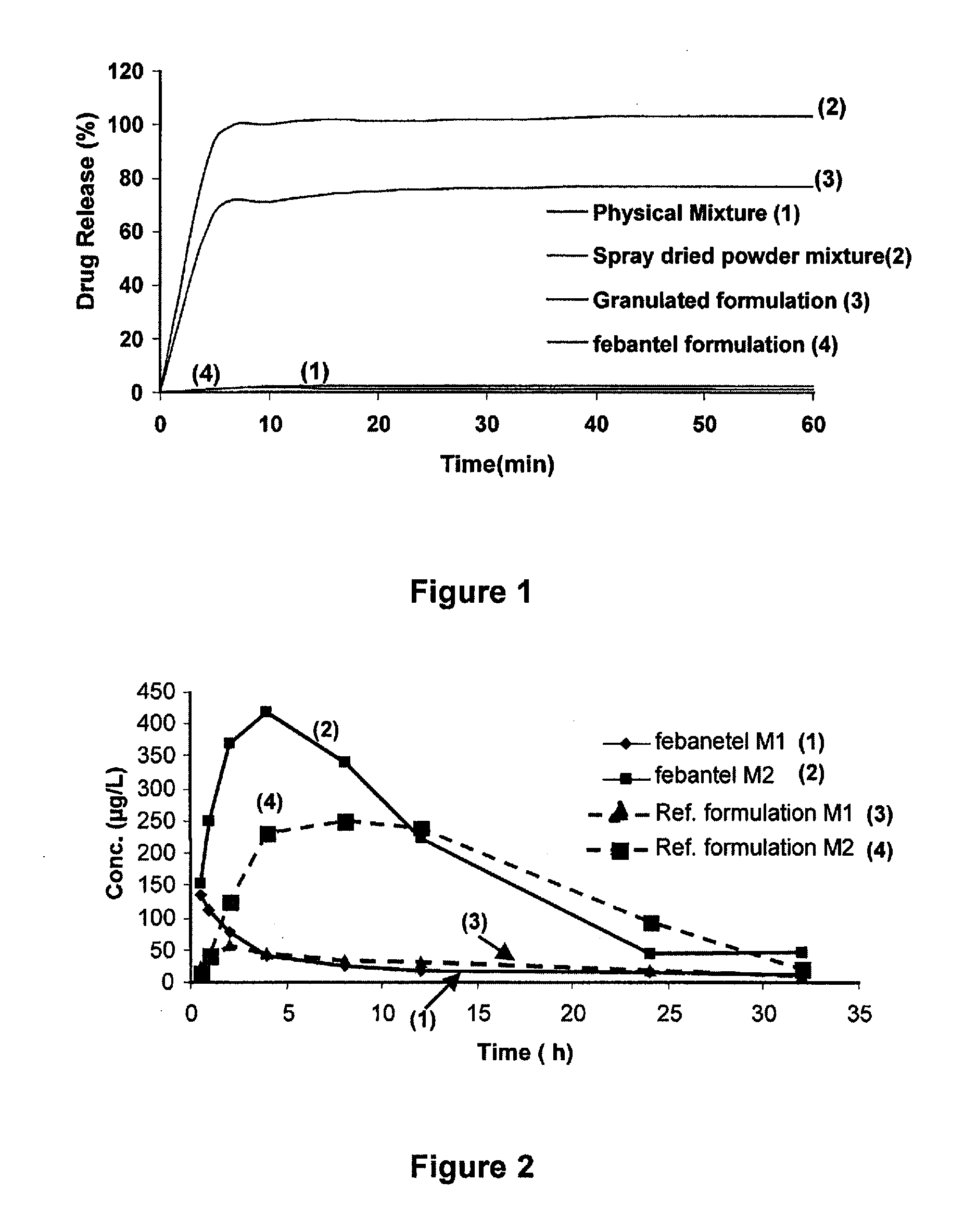Aqueous coacervate compositions suitable for making powders and water-soluble formulations of biologically-active agents
a technology of aqueous coacervate and biological active agents, which is applied in the field of formulations of poorly watersoluble biological active agents, can solve the problems of insufficient water-soluble or water-dispersible water in most newly developed human drugs, inability to practically suit most human administration modes, and inability to achieve water-soluble, water-soluble, and easy-to-use effects
- Summary
- Abstract
- Description
- Claims
- Application Information
AI Technical Summary
Benefits of technology
Problems solved by technology
Method used
Image
Examples
example 1
Preparation of an Aqueous Gel-Free Coacervate System Based on Cremophor EL
[0114]150 g Cremophor® EL (a polyoxyl 35 castor oil non-ionic tensio-active agent commercially available from BASF Corporation) was heated to 150° C. and 60 g febantel (melting point: 127-132° C.) was dissolved in the heated liquid. When the drug was visually dissolved, the solution was kept at this temperature for 2 minutes. Thereafter, the warm solution was added to 1000 ml demineralised water under high shear mixing (using a Silverson L4R device operated at 6000-8000 RPM) and after addition, mixing was continued during 5 minutes. Thereafter, 300 g maltodextrin (dextrose equivalent 18, commercially available as C*PharmDry 01983 from Cargill, France) was slowly added to the liquid under high-shear conditions (using a Silverson L4R device operated at 6000-8000 RPM) and mixed during 5 minutes. After a cooling down period of 8 hours, an upper coacervate phase and a lower equilibrium water phase were obtained.
example 2
Production and Water-Dissolution of a Febantel Powder
[0115]After dispersing the coacervate phase into the equilibrium water phase of the coacervate composition prepared in example 1 by shaking and / or stirring, the formulation was spray-dried to a white free-flowing powder by means of a laboratory scale spray-drying equipment Mobile Minor commercially available from Niro, Copenhagen, Denmark. The feed rate of the dispersed liquid was set at 30 ml / minute, the inlet temperature at 130° C. and the resulting outlet temperature was 58° C.
[0116]A dissolution test in water was performed for the spray-dried free-flowing powder formulation at room temperature (20-25° C.). The test showed that the drug powder formulation was completely dissolved within 5 minutes.
example 3
Preparation of an Aqueous Gel-Free Coacervate System Based on Tween 80
[0117]200 g Tween® 80 was heated to 150° C. and 60 g febantel was dissolved in the heated liquid. When the drug was visually dissolved, the solution was kept at this temperature for 2 minutes. Thereafter, the warm solution was added to 1000 ml demineralised water under high shear mixing conditions (using a Silverson L4R device operated at 6000-8000 RPM) and after addition, mixing was continued during 5 minutes. Thereafter, 400 g maltodextrin (dextrose equivalent 18, commercially available as C*PharmDry 01983 from Cargill, France) was slowly added to the liquid under high-shear forces (using a Silverson L4R device operated at 6000-8000 RPM) and mixed during 5 minutes and stirred afterwards. An upper coacervate phase and a lower equilibrium water phase were obtained.
PUM
| Property | Measurement | Unit |
|---|---|---|
| melting point | aaaaa | aaaaa |
| temperature | aaaaa | aaaaa |
| temperature | aaaaa | aaaaa |
Abstract
Description
Claims
Application Information
 Login to View More
Login to View More - R&D
- Intellectual Property
- Life Sciences
- Materials
- Tech Scout
- Unparalleled Data Quality
- Higher Quality Content
- 60% Fewer Hallucinations
Browse by: Latest US Patents, China's latest patents, Technical Efficacy Thesaurus, Application Domain, Technology Topic, Popular Technical Reports.
© 2025 PatSnap. All rights reserved.Legal|Privacy policy|Modern Slavery Act Transparency Statement|Sitemap|About US| Contact US: help@patsnap.com

